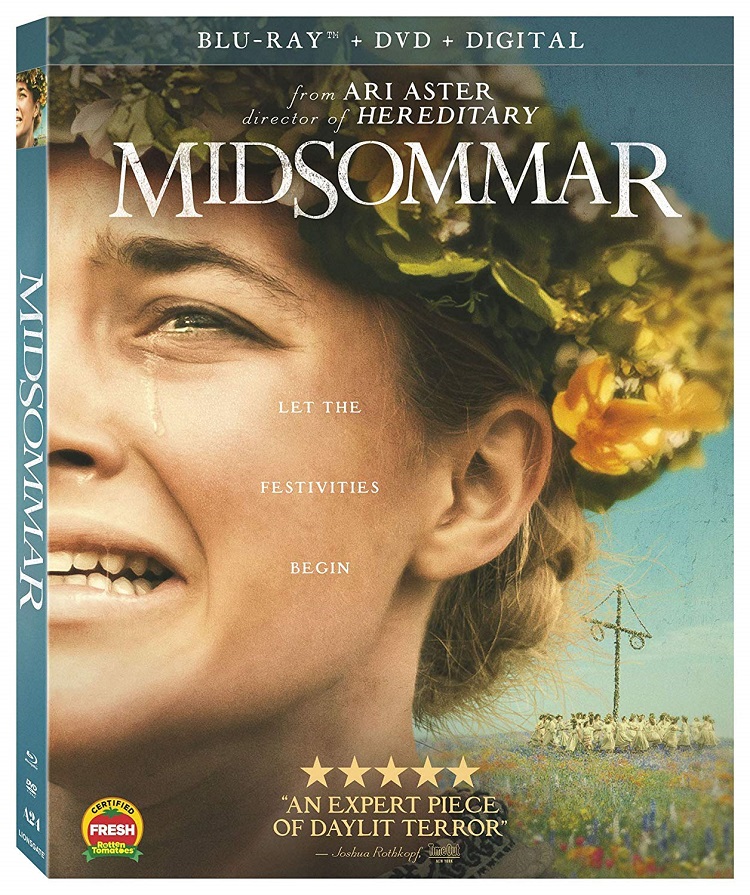
Midsommar is marketed as a horror film, but it’s so different from the typical entries in that genre that it really belongs in a category all its own. While there is a bit of stomach-churning gore and an overbearing sense of dread as writer/director Ari Aster leads us down his twisted rabbit hole, there’s also an intriguing anthropological study of an insular Swedish culture that reveals unexpected layers of beauty in its madness. Where most horror films increase their scares by incorporating night settings, Midsommar frightens viewers in the full light of day during a festival occurring during the season of midnight sun.
After a young American woman suffers a terrible family loss, her boyfriend takes her on a trip with his friends to a festival in a remote Swedish village. The friends discover that they’re visitors in a cross-cultural experience so wholly foreign to them that it may as well be a different planet, and quickly learn that they are so far out of their depth of understanding that they don’t even have a frame of reference for the madness surrounding them. When the merriment of the summer festivities gives way to some horrific acts, they’re trapped in a frightening situation with no apparent way out.
Aster plays with the concept of foreign tourism, as the Americans are put at a disadvantage by a language gap with the Swedes where they’re never quite sure their hosts are accurately describing what’s happening during the festivities, and are fearful of offending their hosts by not following directions. They’re also off-balance due to the omnipresent daylight and recurring recreational drug use incorporated into the festivities, making for a situation where literally anything can happen due to their vastly reduced defenses.
Lead actress Florence Pugh has been on a tear over the past 12 months with impressive lead roles in Fighting with My Family, the AMC miniseries The Little Drummer Girl, and her masterful turn here, with director Greta Gerwig’s presumed Oscar-bait Little Women still on deck before the end of the year. She fully conveys the terror of her Midsommar character’s situation without seeming like a victim, always with a hint of danger behind her eyes speaking to hidden strength. She’s a delight to watch, and further increases anticipation for her expected emergence as Marvel’s next Black Widow next year. She’s joined by Will Poulter and Jack Reynor, fellow UK actors approximating U.S. accents, along with the only legit U.S. actor William Jackson Harper (The Good Place) as the group of hapless Yanks ensnared in the Swedish madness. The men are all fine in their roles, but this is all Pugh’s show.
Aster cements his status as a director to watch, exhibiting full mastery of the craft belying his young age. He’s assembled something remarkable here: a horror film that plays more like an art film. It’s not really all that scary or gory, it’s more just plain weird and delightfully original, like a Bjork music video stretched to feature length. There’s a certain beauty in the pagan rituals portrayed on screen, especially since they take place entirely in the exposure of full daylight, and Aster mines his unique concept to its max, delivering unsettling chills in the midst of lovely midsummer pageantry.
The primary bonus feature is a generous half-hour look at the film’s production, including interview footage with the cast and Aster. It’s well worth a look for viewers interested in more background information about the film, especially the surprising revelation that it was filmed in Hungary, not Sweden. The only other bonus feature is a throwaway joke promo called Bear in a Cage shot like a TV ad for a fake product promoting the film, seemingly only here because it might have amused Aster. After what he’s accomplished with his film, he’s more than welcome to have a laugh with this bonus.